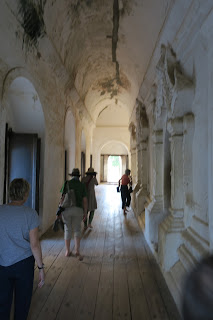Maha Aungmye Bonzan Monastery, commonly known as the Me Nu Brick Monastery, is a historic Buddhist monastery in Inwa, Mandalay Region, Myanmar (Burma).
The monastery was built by Queen Nanmadaw Me Nu in 1818 to serve as the residence of her religious preceptor, the Nyaunggan Sayadaw. The monastery was restored in 1873 by Queen Hsinbyumashin.
|
Climbing towards the monastery gate. |
|
Monastery gate. |
|
Sign giving some information about the monastery. |
|
Approaching the monastery. |
|
Southwest corner of the monastery.
|
|
South side of the west pavilion. |
|
South entrance to the west pavilion. |
|
Detail of the south entrance door of the west pavilion. |
|
South entrance to the east pavilion. |
|
Southeast corner of the monastery. |
|
East side of the monastery. |
|
Free space between the east pavilion (left) and the west pavilion
(right).
|
|
North entrance to the east pavilion. |
|
Set of stupas located east of the monastery. |
|
Entering the west pavilion through one of the east entrances. |
|
Interior of the west pavilion. |
|
Golden statue of Buddha in one of the rooms of the west pavilion. |
|
Leaving the monastery. |
See also
Source
Location





















